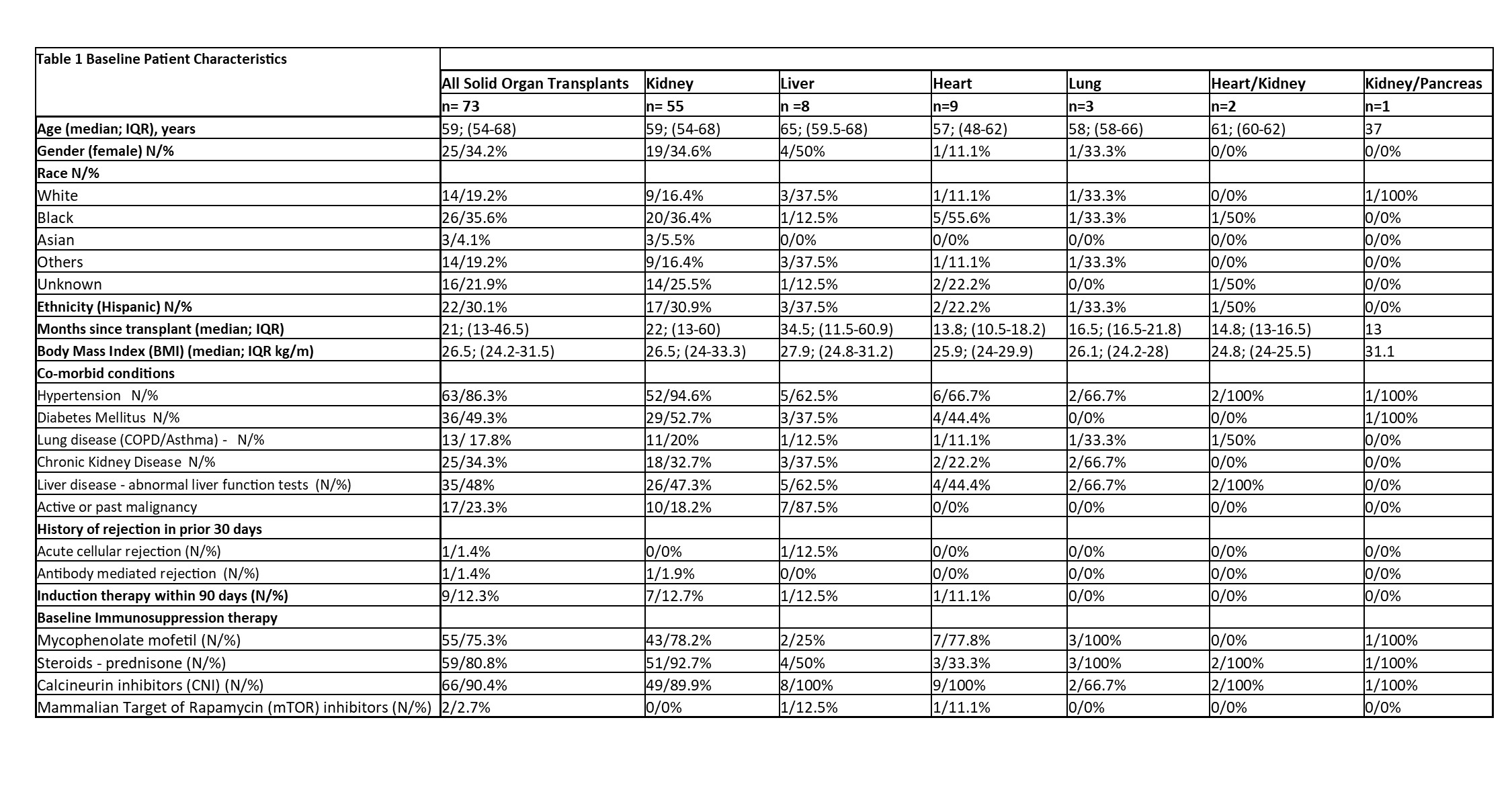Clinical Signs Predictive of Covid-19 Mortality Among Transplant Recipients
D. Ginzberg1, K. Pierce2, E. Kreiger-Benson2, M. Graves2, H. Neumann3, N. Ali3, C. Gidea3, J. Park3, S. Mehta3
1Hackensack University Medical Center, Hackensack, NJ, 2New York University Grossman School of Medicine, New York, NY, 3New York University Langone Transplant Institute, New York, NY
Meeting: 2021 American Transplant Congress
Abstract number: 735
Keywords: Infection, Pneumonia, Risk factors
Topic: Clinical Science » Infectious Disease » All Infections (Excluding Kidney & Viral Hepatitis)
Session Information
Session Name: All Infections (Excluding Kidney & Viral Hepatitis)
Session Type: Poster Abstract
Session Date & Time: None. Available on demand.
Location: Virtual
*Purpose: The presentation of Coronavirus disease 2019 (COVID-19) ranges from mild illness to severe respiratory failure. Disease progression may differ in immunocompromised patients and immunocompetent hosts. Therefore, we aim to characterize COVID-19 clinical presentation and outcomes in solid organ transplant recipients (SOTRs) to identify initial clinical factors that may predict COVID-19 associated mortality.
*Methods: We prospectively reviewed baseline demographic and clinical characteristics among adult kidney, pancreas, liver, heart and lung transplant recipients diagnosed with COVID-19 between March 1, 2020 and May 5, 2020 at our transplant center in New York City. A series of chi-square and Fisher’s exact tests were conducted to investigate the relationship between several predictor variables (baseline characteristics, symptoms at presentation, and baseline immunosuppression regimen) and 30-day mortality.
*Results: 73 SOTRs (53 kidney, 8 liver, 7 heart, 3 lung, 2 heart/kidney) with SARS-CoV-2 PCR-confirmed COVID-19 were included in the final analysis. Median age was 59 years (IQR 54-68) and 34.2% were female. Median time since transplant was 21 months (IQR 13-46.5). All patients were on baseline immunosuppresion as shown in table 1. The majority of patients were diagnosed in the Emergency Department. Most common presenting symptoms were cough (68.5%), gastrointestinal symptoms (54.8%) and dyspnea (45.2%) with median of 5 days from symptom onset to hospitalization. All patients had elevated inflammatory markers at time of diagnosis (median CRP 54 mg/L, median ferritin 704 ng/mL, median procalcitonin 0.11 ng/mL, median D-dimer 311 ng/mL). 84.1% of patients required supplemental oxygen, including intubation in 19.7%. 13 of 63 (21%) hospitalized patients died. Dyspnea on presentation was the only baseline or presenting patient factor found to be predictive of death (p =.004). When stratified by initial chest X-ray findings, dyspnea combined with abnormal chest X-ray predicted mortality (p=.021) while dyspnea with normal chest X-ray did not.
*Conclusions: Presenting symptoms of dyspnea and radiographic signs of pneumonia on initial imaging predicted mortality among SOTRs with COVID-19 in our cohort. These findings can inform allocation of limited resources in COVID-19 management, including the triage and timing of COVID-19 directed therapies early in the illness course among different patient populations.
To cite this abstract in AMA style:
Ginzberg D, Pierce K, Kreiger-Benson E, Graves M, Neumann H, Ali N, Gidea C, Park J, Mehta S. Clinical Signs Predictive of Covid-19 Mortality Among Transplant Recipients [abstract]. Am J Transplant. 2021; 21 (suppl 3). https://atcmeetingabstracts.com/abstract/clinical-signs-predictive-of-covid-19-mortality-among-transplant-recipients/. Accessed December 28, 2025.« Back to 2021 American Transplant Congress

